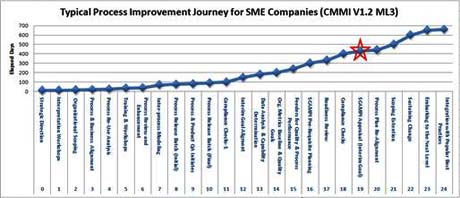
Typical Engagement Life Cycle for Small & Medium Size Companies
Organizations of employee size ranging from 10 ~ 200 have unique challenges to overcome. With a clear focus to grow and succeed, these companies come forward with a great amount of zeal and champion the cause of process change. Though it is said starting a fresh is the best way to create knowledge, we have seen that smaller companies take the learning curve a little too long and delay the initiative. This may be due to any of the following challenges:
- Previous experience stating that it should be self-driven but it is taking long.
- Myths leading to believe that only Large Companies can implement these models.
- Myths that process improvement would lead to additional overheads and more Documentation.
- Lack of appropriate exposure to the process improvement methodologies.
- Incorrect interpretation of the model/ framework being considered.
- Limited practical exposure to management techniques and know-how.
- Limited resources that could support the initiative.
- Lack of funds.
- Unsure which model would suit their needs, and how long would it take.
- Less or no focus on training programs.
The typical approach we propose to these companies is modelled as per following timelines.

Typical Engagement Life Cycle for High Maturity Initiatives

High Maturity Initiatives are the next step to a defined process architecture. With projects and products using the processes, and analytics feeding in the data for improvement, the organization graduates towards understanding process and product capability. A well refined insight into the process network with process elements and data handlers which enable the gauging of process/ product efficiency. With data plots on natural bounds, graduating towards defining control limits the efficiency parameters were re-aligned with interim goals. Unique prediction models were derived from regression equations which enabled the project owners to gain confidence on the product/work product capability.
Some of the challenges which organizations face in the journey for High Maturity are:
- Incorrect knowledge and wrong interpretation of high maturity requirements
- Lack of 'Good Data'
- Lack of or less Statistical Knowledge
- Insufficient data of related processes and sub-processes
- Incorrect identification of variation parameters
- Incorrect choice of Innovation Variables
- Force fit of time schedules for understanding stability/ capability





